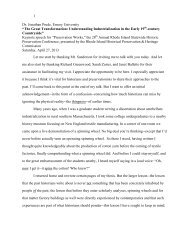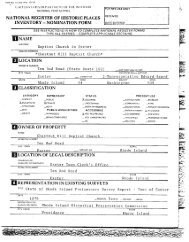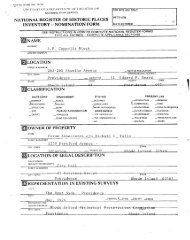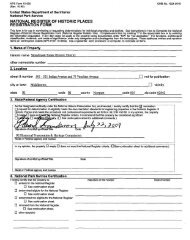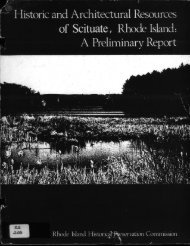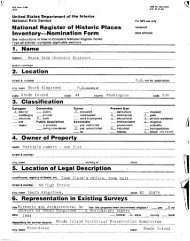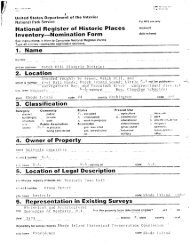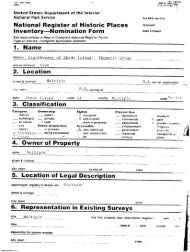National Register of Historic Places Registration Form
National Register of Historic Places Registration Form
National Register of Historic Places Registration Form
You also want an ePaper? Increase the reach of your titles
YUMPU automatically turns print PDFs into web optimized ePapers that Google loves.
NPS <strong>Form</strong> 10-900-a 0MB Approval No- 1024-00188-86United States Department <strong>of</strong> the Interior<strong>National</strong> Park Service<strong>National</strong> <strong>Register</strong> <strong>of</strong> <strong>Historic</strong> <strong>Places</strong>Continuation SheetPropertyname Clement Weaver - Daniel Howland House. Kent County, P.1.Section number 8 Page 12SignificanceThe Clement Weaver House is architecturally significant for its age,rarity, and essential seventeenth-century integrity. The house is alsoimportant as the house <strong>of</strong> one <strong>of</strong> East Greenwich’s first settlers,reflecting the town’s early scattered agricultural settlement pattern.Prior to King Philip’s War 1675-76, the East Greenwich area andlands to the south known as the Narragansett Country were occupied byNarragansett Indians and thus largely inaccessible to colonists forsettlement. With the defeat <strong>of</strong> the Indians, and in response to claims onthe territory made by Connecticut, the Phode Island General Assemblyfounded the town <strong>of</strong> East Greenwich in 1677. Clement Weaver was one <strong>of</strong> theoriginal 48 grantees and settlers and, in 1679, constructed or hadconstructed a small house on 117 1/4 acres <strong>of</strong> land given to him inrecognition <strong>of</strong> his service during the war. Clement Weaver d. 1691married Rachel Andrew in 1677; they eventually had seven children, whichmay explain at least the first two additions to the house made duringWeaver’s occupation. -The house stayed in the Weaver family until 1748 when Joseph Weaver,yeoman, <strong>of</strong> East Greenwich, sold it and 104 acres <strong>of</strong> land with allappurtenances to Daniel Howland, yeoman, <strong>of</strong> Portsmouth for 3,000 pounds.The farm passed to Thomas Howland, presumably Daniel’s son, and from theestate <strong>of</strong> Thomas Howland to John Greene <strong>of</strong> Warwick; the farm at this timeincluded only about 50 acres, with a dwelling and other buildings, andbrought $2,500. John Greene sold the property to his daughter AbigailSusan, wife <strong>of</strong> Daniel Howland, executor <strong>of</strong> Thomas Howiand’s estate, for"love" and the sum <strong>of</strong> $100 the same day he purchased it, December 11, 1845.By the time <strong>of</strong> the next transfer <strong>of</strong> ownership in 1868 from Abigail andDaniel Howland to Peleg C. Kenyon <strong>of</strong> Cincinnati, Ohio, and John P. Kenyon<strong>of</strong> Warwick, Rhode Island for $5,000, several lots had been added to thefarm, bringing it back to about 100 acres. Peleg Kenyon subsequently soldhis half to Thomas E. Kenyon <strong>of</strong> East Greenwich for $2,500 in 1876. In1930, Katherine S. Flowland purchased the whole 100-acre farm with dwellingand other buildings and improvements from various Kenyon heirs for the sum<strong>of</strong> $10.00. Photographs <strong>of</strong> the house at this time show it as a vacant,weather-worn shell <strong>of</strong> a house with window-glass missing and shinglesmouldering, a picturesque "colonial ruin," which partly explains the lowprice. Katherine Howland, widow <strong>of</strong> Daniel Howland, sold the same parcel toC. Ellsworth Gale, Jr., <strong>of</strong> Warwick in 1940, after which time, in subsequenttransfers, the landholding associated with the house was reduced to itspresent size. It appears that Norman M. Isham and his associate, Edwin F.






